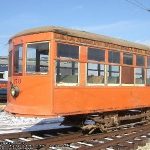Streetcars

Illinois Terminal 170
| Description: | Double-end arch-roof Birney car |
Equipment Information
Illinois Terminal 170 is the only Birney streetcar at IRM. The Birney was a single-truck, one-man, lightweight streetcar developed after the First World War to help smaller streetcar systems that were trying to control spiraling costs in labor and electricity. Though popular with streetcar lines, Birneys were unpopular with the public due to their rough ride and utilitarian amenities. Car 170 was built for use in Galesburg, Illinois and was later transferred to Alton, where its street railway career ended in 1936. Between then and 1957 it served as an office in the St. Louis subway.
COMPARE ME WITH: NKEL&R 116, a pre-Birney single-truck streetcar that like car 170 was designed for small-town use. The NKEL&R car lacks some of the more innovative features of the Birney including its design for one-man operation.
Illinois Terminal 170 Details
Builder: American Car Company
Year Built: 1921
Seats: 30
Length: 27ft 9in
Width: 8ft
Height: 10ft 2in
Weight: 13000 lbs
Brakes: SME
Motors: 2 GE 264
Control: K10
Compressor: DH-16
Trucks: Brill 79E1
Description: Double End / Single Truck / Arch Roof / Birney
Arrived: 1957
Condition: Incomplete / cosmetically restored / not operational
IT 170 Ownership History
1921-1923 – Galesburg Railway Lighting & Power #7
1923-1932 – Illinois Power & Light #7
1932-1957 – Illinois Terminal
1957-present – Illinois Railway Museum, Union, IL
The Birney Car
In the years before the First World War, electric streetcars provided the only good way for most people to travel longer distances within a larger city. Few urban dwellers owned horses and, as cities expanded, street railways provided the link that residents needed between their homes and their jobs. But during the 1910s and 1920s two factors combined to threaten the street railway companies: an increase in automobile ownership and competition from jitneys, or unlicensed taxis. Together, this competition reduced income enough to threaten to make many streetcar companies unprofitable.
The solution was the Birney car, named for its co-inventor, Charles O. Birney. Illinois Terminal 170 is one of hundreds of Birneys dating to between 1918 and 1931 and is typical of the design.
The Birney incorporated several features that made it more efficient to operate. It was smaller and lighter than many older streetcars, lessening power consumption. Importantly, it was designed to be operated by only one man, unlike older streetcars that needed both a motorman to run the car and a conductor to take fares. To make this possible this “one-man operation,” the Birney also incorporated safety features that would automatically stop the car if the operator became incapacitated.
While Birneys were small and rough-riding, the economy of operation and lowered personnel costs made them very attractive to streetcar companies. Even companies for which the Birney was too small to be useful, like Chicago Surface Lines, utilized its features in larger one-man streetcars or converted older streetcars to one-man operation. Birneys were most common on smaller streetcar systems. But even with the reprieve the Birney granted to these operations, most succumbed during the Great Depression. Car 170 was typical; built for use in Galesburg, Illinois, it was transferred to Alton in 1932 and retired only a few years later.
Click to return to Streetcar roster
Click to return to main roster page
